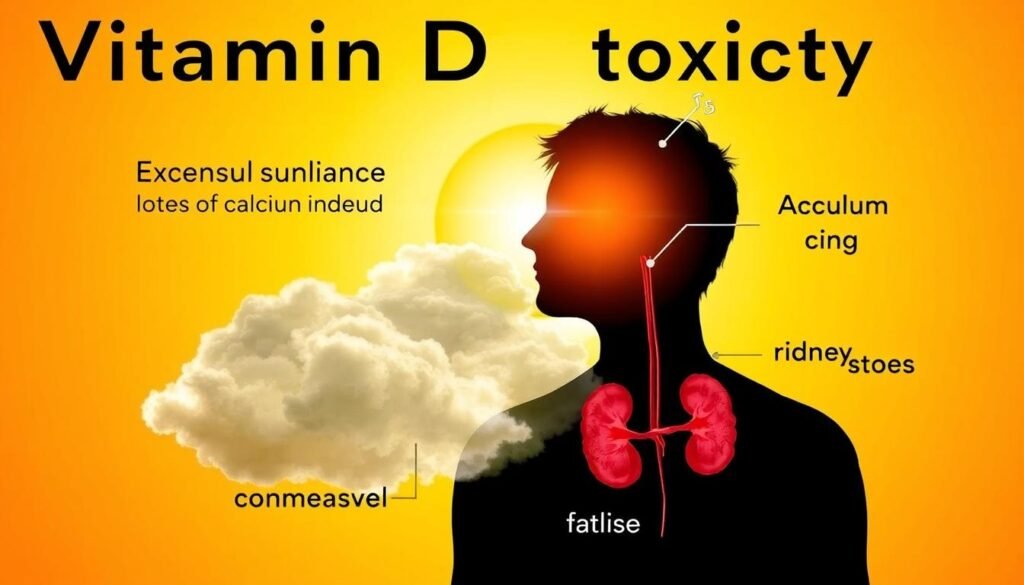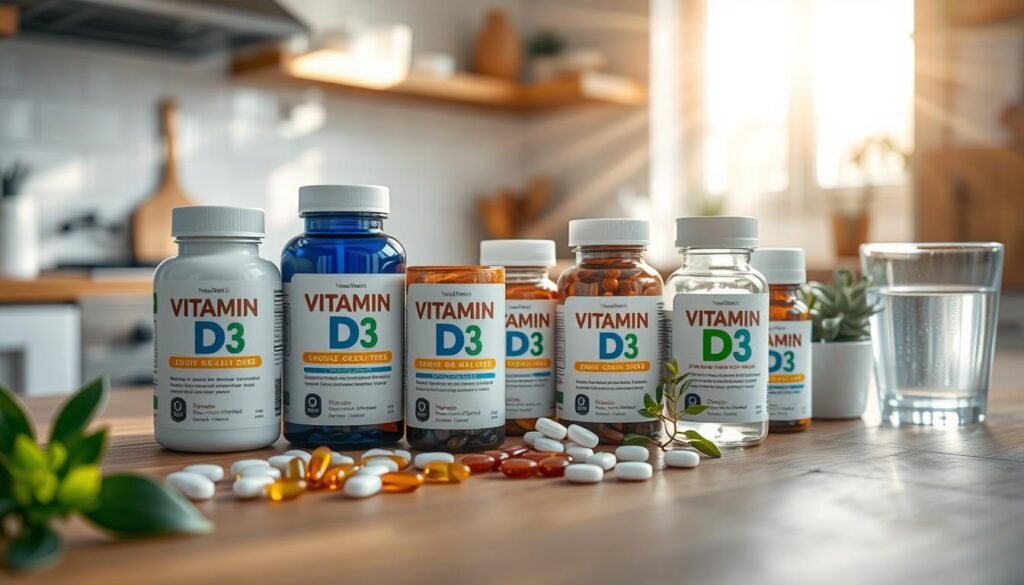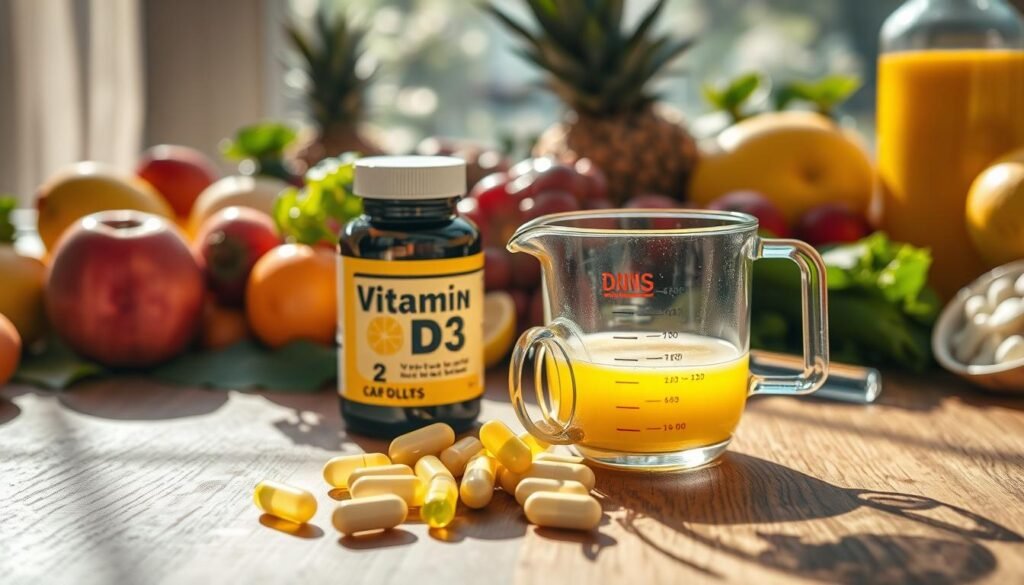Did you know over 40% of the U.S. population lacks enough vitamin D? This fact highlights how important vitamin D3 (cholecalciferol) is for our bones and health. However, too much vitamin D3 can be harmful. It’s key to avoid taking more than what’s suggested.
For instance, if you consume more than 4,000 international units (IU) a day, you might face issues. These can include nausea, vomiting, and even more serious problems like kidney stones and heart complications. We aim to share the risks of too much Vitamin D3. This way, you can stay healthy without risking your safety.
Key Takeaways
- Vitamin D3 is crucial for calcium absorption and bone health.
- Over 4,000 IU of vitamin D daily may lead to significant side effects.
- Common symptoms of overdose include nausea, vomiting, and kidney stones.
- Consult a healthcare provider for personalized vitamin D3 supplementation recommendations.
- It’s essential to consider the interactions of vitamin D3 with other medications.
Understanding Vitamin D3 and Its Importance
Vitamin D3, or cholecalciferol, is crucial for our health. It helps our bodies absorb calcium, which strengthens bones and prevents diseases like osteoporosis. This nutrient also aids muscle function, bolster immune health, and supports brain function. Not having enough Vitamin D3 can cause serious health problems, highlighting the need to maintain good levels in our bodies.
People get Vitamin D3 from certain foods, sunlight, and supplements. Sources include fatty fish, fortified foods, and the sun’s UV rays. Yet, many don’t get enough Vitamin D3, leading to troubling deficiencies. If blood levels of 25(OH)D are below 30 nmol/L (12 ng/mL), it points to a significant lack of this vital nutrient.
The benefits of Vitamin D3 go beyond just bone health. It’s key for muscle and nerve functions and plays a big part in immune responses. Having blood levels of 25(OH)D above 50 nmol/L (20 ng/mL) is good for health. Getting enough sunlight and eating the right foods can help, but some may need supplements. This is especially true for older adults or those not often in the sun.
How Vitamin D3 Works in the Body
Vitamin D3 turns into its active form, calcitriol, in the liver and kidneys. This hormone manages calcium and phosphate to keep bones and teeth strong. It helps absorb these minerals for good bone health.
Vitamin D3 also boosts the immune system. Low levels may make you more likely to get infections and autoimmune diseases. People with enough vitamin D get fewer respiratory infections, like flu and COVID-19.
Vitamin D3 is good for your mind too. It can help with depression and anxiety, improving mental health. Feeling down or anxious? Vitamin D might boost your mood and ease anxiety. You can learn more about this here.
Vitamin D3 has key roles in health. It works on bones, immunity, and mood. It’s part of full health care.
Potential Side Effects of Vitamin D3 Supplementation
Vitamin D3 is crucial for our health, especially for our bones. But, it’s important to know about its possible side effects. Knowing these can help us make better choices about using it. This awareness helps manage any negative effects that might show up.
Common Side Effects
Mild symptoms are common with Vitamin D3. These symptoms include:
- Nausea
- Vomiting
- Poor appetite
- Constipation
These issues aren’t severe but can still be unpleasant. Watching how your body reacts to Vitamin D3 is key. This is even more crucial if you’re taking more than what’s recommended.
Severe Side Effects
Too much Vitamin D3 can lead to serious problems. Symptoms of too much Vitamin D include:
- Confusion
- Disorientation
- Heart rhythm problems
- Kidney stones
- Kidney damage
People with certain health issues may be more at risk. High levels of Vitamin D can cause high calcium in the blood. This can result in muscle weakness, tiredness, and confusion.

Recommended Dosage and Safety Guidelines
It’s important to know about Vitamin D3 dosage for health. The right daily amount depends on age and needs:
| Age Group | Recommended Dosage (IU) |
|---|---|
| Infants | 400 |
| Children (1-70 years) | 600 |
| Adults (71+ years) | 800 |
Following Vitamin D3 guidelines helps avoid risks. Get regular checks if you’re at risk of too much or too little vitamin D.
Getting enough vitamin D can be hard for people in cold places or with limited sun. Age, skin color, and some health issues can make it harder to get or use vitamin D. Without enough, you could get diseases like osteomalacia or rickets.
To fix low vitamin D, adults might take a supplement of 5000 IU daily. But a health pro should set a child’s dose.
Too much vitamin D isn’t good, so watch out. Talk with a health expert to get your Vitamin D3 dosage right.

Risk Factors for Vitamin D3 Overload
The Vitamin D overdose risk mostly comes from taking too much supplement. Sun exposure or food rarely cause it. Knowing what increases the risk of too much Vitamin D helps people make better health choices.
Getting too much sun seldom leads to overdose because our body can handle it. However, taking supplements in high doses is more risky. Supplements that are much higher than the 600 IU daily suggested amount can be dangerous, especially if you take 60,000 IU for a long time.
Some health issues can make Vitamin D overdose more likely. If you have kidney problems, for example, your body might not handle Vitamin D well. Older people and those with issues absorbing nutrients also face greater risks. Also, children accidentally getting too much Vitamin D is a worry, showing we need to watch how much they get.
| Risk Factor | Description |
|---|---|
| High-Dose Supplementation | Taking too much vitamin D supplement can cause overdose. |
| Kidney Disorders | These can make processing Vitamin D harder, raising overdose risk. |
| Aging | Older people might need to adjust their dose. They’re more at risk. |
| Malabsorption Syndromes | Issues with absorbing nutrients can make Vitamin D harder to process. |
| Childhood | Kids have a higher risk of accidentally getting too much Vitamin D. |

High Vitamin D levels, over 100 ng/mL, show too much intake. Levels above 150 ng/mL mean serious overdose. Knowing the factors leading to Vitamin D toxicity helps avoid health problems from too much Vitamin D.
Interactions with Other Medications
The way Vitamin D3 works can be changed by different medications. Knowing about these interactions is key, especially for those taking Vitamin D3 and other treatments. Some medications, like anticonvulsants, can affect how Vitamin D is processed and taken up by the body.
Interactions with Anticonvulsants
Anticonvulsants, such as phenobarbital and phenytoin, impact Vitamin D3 drug interactions. They can lower its levels and how well it works. These drugs make the body break down Vitamin D faster, leading to less Vitamin D in the blood. People using anticonvulsants should talk to their doctors about Vitamin D supplements.
Interactions with Other Supplements
Medications and other supplements can also change how Vitamin D is absorbed. For example, atorvastatin can increase Vitamin D levels in the blood. But, taking it with Vitamin D may make atorvastatin less effective. Other drugs, like cholestyramine and some steroids, can hurt calcium uptake and Vitamin D’s effectiveness. Here’s a list of key medications and their impacts on Vitamin D absorption:
| Medication Type | Effect on Vitamin D |
|---|---|
| Anticonvulsants (Phenobarbital, Phenytoin) | Decrease Vitamin D effectiveness |
| Atorvastatin | Increases Vitamin D levels |
| Cholestyramine | Impairs calcium absorption |
| Corticosteroids | May lead to bone loss |
| Thiazide Diuretics | Risk of hypercalcemia in certain populations |
Knowing about medications affecting Vitamin D absorption is important. Talk to a healthcare provider for advice. This ensures good management of Vitamin D supplements and other medicines for your health. Find more information here.
Managing Side Effects of Vitamin D3 Supplementation
Managing Vitamin D3 supplementation is key for our health. Every year, over 4,000 people in the U.S. get too much vitamin D. This makes it important to watch blood levels and stick to the right dose. Doing this helps keep us safe and healthy.
Getting regular check-ups is helpful. It’s especially important for those over 65. They might not get enough vitamin D from food. Doctors often check kids and infants’ blood when treating them for low vitamin D. This helps keep them safe.
The right amount of Vitamin D3 varies by age and health. Adults should take 800 units daily for good health. Meanwhile, people with certain conditions should not take vitamin D at all. High doses are risky for pregnant and breastfeeding women. It could harm both the mother and the baby.
| Age Group | Daily Vitamin D Recommendation (IU) | Monitoring Requirements |
|---|---|---|
| Infants | 400 | Regular blood tests |
| Children | 1000-2000 | Regular blood tests |
| Adults | 800 | Periodical blood tests |
To avoid vitamin D3 toxicity, know the safe levels and risks. A balanced diet and talking to doctors is helpful. By being careful, we can enjoy vitamin D’s benefits without its downsides. This way, we can stay healthy and strong.
Alternatives to Vitamin D3 Supplementation
For those wary of supplements, several vitamin D3 alternatives are available. Getting vitamin D naturally is possible, such as through sunlight. Around 15 to 30 minutes of sun a few times a week can greatly increase vitamin D levels for many.
Another method includes adding vitamin D-rich foods to your diet. Fatty fish like salmon and mackerel are great sources. Other options include:
- Fortified milk and orange juice
- Egg yolks
- Mushrooms exposed to UV light
Natural dietary sources of Vitamin D are a safe way to keep serum levels adequate. Knowing about these natural sources can encourage better eating habits.
Choosing the right foods can lessen the risks associated with vitamin D deficiency. Focusing on these natural sources can significantly improve health and wellness.
Conclusion
Knowing the side effects of Vitamin D3 helps you get the most out of it. This overview highlights its role not just in bone health but in overall wellness. But if you already have enough Vitamin D, taking more might not help. Large studies show it doesn’t prevent cancer, heart problems, or diabetes in those cases.
To make the most of Vitamin D, follow safe dosage tips. Get your Vitamin D from the sun and food too. Aim for a Vitamin D (25(OH)D) level of about 30 ng/mL for the best health. Always check with doctors to get advice that fits you.
Getting your Vitamin D balance right boosts your body and mind. If you’re curious about Vitamin D and mental health, like how it might affect anxiety, there’s more to learn. You can find useful information here.